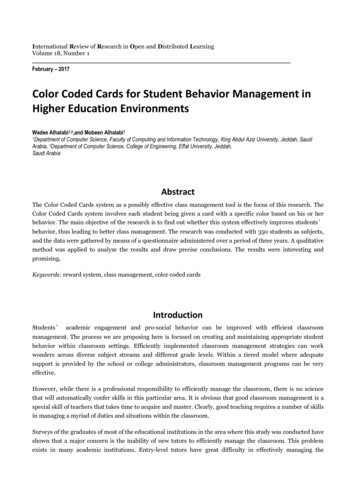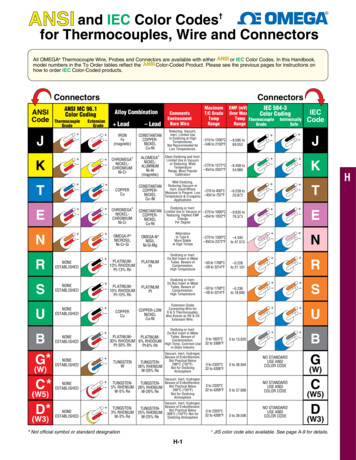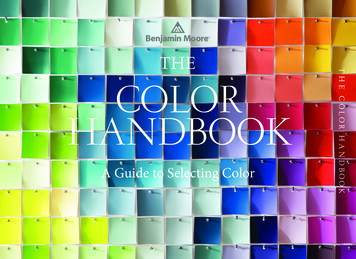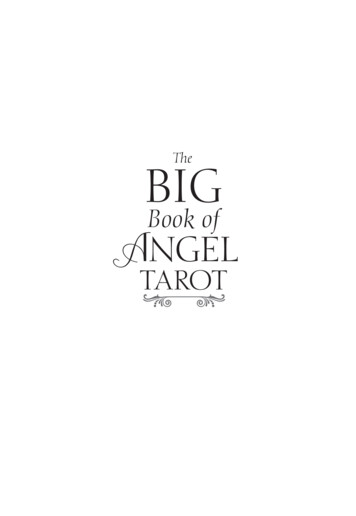
Transcription
International Review of Research in Open and Distributed LearningVolume 18, Number 1February – 2017Color Coded Cards for Student Behavior Management inHigher Education EnvironmentsWadee Alhalabi1,2,and Mobeen Alhalabi11Department of Computer Science, Faculty of Computing and Information Technology, King Abdul Aziz University, Jeddah, SaudiArabia, 2Department of Computer Science, College of Engineering, Effat University, Jeddah,Saudi ArabiaAbstractThe Color Coded Cards system as a possibly effective class management tool is the focus of this research. TheColor Coded Cards system involves each student being given a card with a specific color based on his or herbehavior. The main objective of the research is to find out whether this system effectively improves students’behavior, thus leading to better class management. The research was conducted with 350 students as subjects,and the data were gathered by means of a questionnaire administered over a period of three years. A qualitativemethod was applied to analyze the results and draw precise conclusions. The results were interesting andpromising.Keywords: reward system, class management, color coded cardsIntroductionStudents’ academic engagement and pro-social behavior can be improved with efficient classroommanagement. The process we are proposing here is focused on creating and maintaining appropriate studentbehavior within classroom settings. Efficiently implemented classroom management strategies can workwonders across diverse subject streams and different grade levels. Within a tiered model where adequatesupport is provided by the school or college administrators, classroom management programs can be veryeffective.However, while there is a professional responsibility to efficiently manage the classroom, there is no sciencethat will automatically confer skills in this particular area. It is obvious that good classroom management is aspecial skill of teachers that takes time to acquire and master. Clearly, good teaching requires a number of skillsin managing a myriad of duties and situations within the classroom.Surveys of the graduates of most of the educational institutions in the area where this study was conducted haveshown that a major concern is the inability of new tutors to efficiently manage the classroom. This problemexists in many academic institutions. Entry-level tutors have great difficulty in effectively managing the
Color Coded Cards for Student Behavior Management in Higher Education EnvironmentsAlhalabi and Alhalabistudents in the classroom (Emmer, E. T. & Sabornie, E. J, 2015). While we cannot derive a generic conclusionabout this situation, as one solution cannot fit all of its variations, here is an essential list of things that might beof help under most circumstances. Classroom management skills must be developed by tutors as a crucial partof an efficient system of teaching and practice. These skills are acquired over time through rigorous practice,feedback, and the complete willingness of the tutor to learn and grow in the domain of teaching. Some of thebasic factors that must be considered by any tutor who desires to be better in handling different situations arecommon sense, presence of mind, and a sense of fairness combined with courage, consistency, skills, andexpertise in the subject matter of the course. Overall, a tutor must be able to see all the students from theirperspective. This efficient monitoring and supervision helps with efficient classroom management.Literature ReviewSchool class management is very important for keeping discipline in the classroom and on the overall campus.When class management is done properly, students get more attention from their teachers and they pay moreattention to their studies and the curriculum. In order to achieve an excellent educational environment on theschool campus, all the teachers, educators, lab instructors, and other administrative officers must take classmanagement as a challenge, and go through different processes to apply better class management methods(Starr, 2010). The aim of all behavior management techniques is to enable students to take ownership of theirbehavior in a manner respectful of the rights of others (Emerson, 1995). One approach to achieve this result isthrough positive behavioral support, an approach developed as an alternative to manage students withdisabilities who engaged in self-endangering and aggressive behavior. “Positive behavioral support is a generalterm that refers to the application of positive behavioral interventions and systems to achieve socially importantbehavior change.” (Sugai et al., 2000, p. 133). Positive behavioral support integrates behavioral sciences,social values and systems perspectives.One method of providing positive behavioral support is the color coded cards system, which is the topic of thispaper. In the following section, two different types of class management tools are presented. Though there aresome differences in names, number of colors, and ways of expression, there are similarities in their processes.Behavior Management Pocket ChartPowerful pocket chart systems can help students take responsibility for their own behavior and traits. Whenthey are unable to score high in this system it badly affects their self-esteem. Similarly, when they are unable toacquire the best colors provided by the system their image declines among their classmates. The best color isgreen, which means they are fine in behavior as per the assessment of the tutor. Yellow represents a warning.Simple color-coding practices aid the students to see, at a glance, each other’s status. They strive to worktowards earning better colors. The whole idea is communicated to the parents, too. Progress cards point out tothe parents the children’s behavior in the academic institution.Some important aspects of efficiently managing a classroom are (a) framing the rules chart; (b) making thepoints clearly understood by each student; (c) explaining why the rules are necessary and what happens if thereare no rules at all in the classroom; (d) listening to the students’ comments and opinions in order to know moreabout their thought processes, and to point them in the right direction; and (e) letting the students start everyday with a green card, to begin the day as though they are doing fine. During the day, the students that are notfollowing one of the rules are asked to remove the green and to bring the yellow card to the front of theirpockets. This has an impact on the students, forcing them to pay attention to their own behavior in theclassroom. Continuously failing to follow the rules means the student will be given an orange card, which197
Color Coded Cards for Student Behavior Management in Higher Education EnvironmentsAlhalabi and Alhalabiindicates that there are consequences that will be faced due to the wrong behavior. Finally, when the orange isremoved and the red card is shown, the student has had a series of wrong actions; this means that there will besome strict reprimands and serious consequences such as asking the student to go and meet the headmaster,principal, or other appropriate member of the management. At the end of each week, the records are sent toparents so they can see the behavior of their children. The parents must sign these records and send them backto the school management. This shows they know what has happened in the school, and they can take actionand motivate their children towards improvement (Jenna, 2016).There is a possibility of engaging parents and guardians in the students' education and behavior management(Zhang et al., 2015). This could be achieved by exposing the class management system through social media. Itwould be a great idea to incorporate the color coded card system with social media, so the family are fully awareof the students’ achievements and behavior. The teacher’s intention is to use information and communicationtechnology (ICT) in this way to motivate the students (Boe, Gulbrandsen, & Sorebo, 2015). The study reportedin Boe et al. (2015) gives a clear indication that if we incorporate ICT in future work, this would have greaterimpact on student motivation. Buckley studied knowledge sharing through a community of practice (CoP).Most of the participants in that study supported and accepted the CoP elements or features (Buckley, 2012).Such a study encourages us as researchers in the same area to facilitate this technique. However, we did notinclude the technique in our paper, but we are considering it in future work.Color Coded Card SystemA well-defined color coded card system must break down the school hours into sections, two or three per day.Based on these sections, the students are rewarded with the rank they have earned during the course of the day.The ultimate goal is to address the behavior of the students, so half-day positions in terms of colors gained willshow at a glance the grade of the student to the others. As time passes and the students become accustomed tothe concepts and the best approaches to stay within the top ranks, then the understanding of how to behave inthe classroom environment is deeper. It shows that they are well trained to adapt to the situational needs of theclassroom and to follow the rules and regulations. The students are delighted to earn colors, and this positiveenforcement of behavior is very effective in the institutional environment. In addition, it shows clearly to theparents the behavior of the students at the end of each school day.In our paper, the results of using four color codes are discussed: white and green for rewards, yellow and red forpenalties. Students having an outstanding performance in the class are rewarded with white cards, while greenis given for actions relevant to helping the authorities. Similar studied was perfrmed using three colors inelementary school (Glenda,, 2004). Ultimately, this paper demonstrates that the positive behavior of thestudents can be reinforced by the implementation of a color-coded card system, or a ticket system or any othersystem set up in the classroom. In addition, by applying this system from early ages, specific learning patternsare understood and the correct behavior becomes second nature. This system underlines the need for rules andemphasizes that following rules (not just in school but also in social situations) is a positive aspect of behaviorthat ensures that the individual follows the general rules defined by society. This is what motivates the studentsto be more responsible individuals, thus leading to a better future for humankind as a whole. The role of theteacher and the academic curriculum has a big influence in redefining tomorrow for all of humankind.Understanding that responsibility when framing the rules in the chart, and making it simple enough to beunderstood by the student in the classroom are important aspects of teaching that must not be neglected.198
Color Coded Cards for Student Behavior Management in Higher Education EnvironmentsAlhalabi and AlhalabiNegative Impact of Behavioral Assessment SystemsIt can be useful to assess the results of this system in the classroom. A series of specific actions common to theshame-based systems are taken into consideration. In some cases, instead of producing the desired effects, theresults were not productive. For example, consider the situation where the card earned is yellow instead ofgreen. The general consensus is that the student will try to earn a better card soon. For this, he or she mustbehave according to the rules set for all students in that specific environment. When they misbehave, seeingtheir name on the board with the corresponding grade should be a clear-cut reminder of their poor behaviorchoice.When a student misbehaves and is listed, he or she is isolated and gains a different identity, being recognized inthe student’s community in a different way (Shindler, 2009). On some level, this facilitates them to meet somebasic needs. Students that have received such notices again and again receive attention. First time offendersmay only get confused about the state of their actions and position in the group. However, repeated listing onthe chart attracts recognition. The power to bring their name to the board as often as possible is assumed to bea power to gain attention. Changing cards does not require a big effort and it is often done any time they need togain favors from parents or the person in change. Being recognized feels good for some kids. Psychologically,the unconscious mind does not make the distinction if the attention is good or bad, but loves to be recognized.Simply put, most forms of attention lead to good feelings, as compared to lack of attention. Tolerating atemporary sense of embarrassment in public is not a big deal for these students who get used to it. Shame basedbehavioral assessment can be analyzed for its effective results and then adjusted accordingly in any school. Inthat way, when the applied system creates problems in a majority of cases, it means that the strategy still needsto be refined further to achieve the desired objectives.Using Advanced TechnologiesThe latest technologies such as social media and the web can be employed to assign colors to the students'actions. The student who got a particular card will have his data uploaded onto the school pages and accessedby parents, so we can collect feedback from parents to enhance class management. Using the latest technologyhelps the parents to know about their children and to give feedback easily.MethodologyTo keep the students in a routine and disciplined student life, there are rules and regulations made for them. Inthe K-12 system, students can be easier to manage with the help of the systematic approaches used in mostschools. When these students go to universities or colleges, however, they are more mature and can be moreresistant to the authority of the teacher. To achieve better school management at this stage of the educationalprocess, the color coded cards system has been proposed, and was used in the classes studied in this researchproject. In this system, cards were given to the students according to their behavior in the class. The followingbehaviors were considered as misconduct behaviors in the class: Talking to other students Talking on the cellular phone Using the laptop or any electronic devices Using the chat on the smart-phone199
Color Coded Cards for Student Behavior Management in Higher Education EnvironmentsAlhalabi and Alhalabi Not switching the cellular phone to silent mode, etc.The study was conducted in Saudi Arabia starting in spring 2013 and continuing until fall 2015. The institutionsthat were studied are King Abdul Aziz University (KAU) with 100 students (70% girls and 30% boys, of which50% are graduates and 50% are undergraduates), Effat University with 100 students (all undergraduate girls),UMM Alqura University (UQU) with 80 students (girls to boys ratio of 4:1, all at undergraduate level) andCollege of Technology, Makkah, (70 undergraduate boys).While a teacher presents a lecture in the class, each of the above behaviors is considered a misconduct. Eachtime a student commits one of these offences a color coded card is given to him or her; the color of the cardrepresents the student’s behavior and attentiveness. Better colors indicate good behavior, while worse colorsshow less attentiveness or bad behavior. There are four colors in the system. Yellow is given to the student whenhe or she misconducts only one time during the class time. If the student misconducts again (the same action)during the same class time, then he or she gets a red card which means a penalty. The other two colors arewhite and green. These are rewarding colors. If a student behaves, then he or she could be rewarded with agreen card. On the other hand, white cards are given to the students with outstanding attention or performancein the class.For this research, the students’ opinions were considered after a successful session in which the color codedcard system was used. Students’ opinions were collected using a questionnaire that was carefully designed toallow respondents to express precise opinions about all the main points of the research topic. Thequestionnaires were delivered to the students at the institutions participating in the research and the responserate was almost 100% (Savenye, W. C., & Robinson, R. S, 2004). The entire color coded cards system wasobserved properly, then the questionnaire was designed. It was designed in such a way that the students couldanswer all the questions properly, and not miss any of the questions. The questions were printed on a singlepage because in many cases it was observed that a person fails to answer the questions on pages other than thefirst. The questions were Multiple Choices Questions (MCQ); the students had to put a tick mark on theiranswer corresponding to their opinion. Different questions had different scales, such as “yes or no,” “bad, good,or very good,” etc.Before the questionnaire was distributed to the students a pilot survey was conducted to show whether anypoint was missing. Expert advice was taken when designing the questionnaire to ensure that all the neededinformation was included and filled in. To collect the answered questionnaires there were several boxes in eachacademic building, so the students could easily submit them.ResultsThe questionnaire was as follows:200
Color Coded Cards for Student Behavior Management in Higher Education EnvironmentsAlhalabi and AlhalabiTable 1Questionnaire1.What is your perception of the color coded cards system?I. ExcellentGoodMakes no difference2. Which color do you think more effective among your classmates?II. YellowRedGreenWhite3. Do you think some of your classmates have had a behavior change based on this system?III. YesNoMaybe4. Devices and behavior affected by this system?IV. MobileOthers5.Laptop or iPadOther electronic devicesTalkingDid you discuss this system with friends, family members or anyone other than your classmates?V. YesNo6. Do you think this system is effective in class management?VI. YesNoMaybeThe questionnaire was delivered to 350 students, as described above. Also as noted above, almost all of thestudents completed the questionnaires and submitted them. However, some of the questionnaires were nottaken into account because they did not have precise answers.201
Color Coded Cards for Student Behavior Management in Higher Education EnvironmentsAlhalabi and AlhalabiTable 2Results of the Questionnaire1.What is your perception of the color coded cards system?VII. Excellent 66.48%;Good 22.04%;Makes no difference 11.48%2. Which color do you think more effective among your classmates?VIII. Yellow 42%;Red 33%;Green 8% ;White 17%3. Do you think some of your classmates have had a behavior change based on this system?IX. Yes 74.85%;No 10%;Maybe 15.15%4. Devices and behavior affected by this system?X. Mobile 32.13%;5.42%5.Laptop or iPad 9.45%; Other electronic devices 29%; Talking 24%;OthersDid you discuss this system with friends, family members, or anyone other than your classmates?XI. Yes 76.82%;No 23.18%6. Do you think this system is effective in class management?XII. Yes 76.52%;No 19.66%;Maybe 3.82%When the students were asked about their perception of the color coded cards system, only 11.48% of thestudents replied that they did not see any difference after the system was applied in the class, while 22.03% feltthe system was a good tool of class management, and 66.48% felt the system was excellent. Figure 1 shows theresult.Figure 1. Perception of the system.When the students were asked about which color they think is most effective among their classmates, 42% ofthem selected the yellow color. This indicates that it is quite difficult to pass the entire class-time bymaintaining all the rules and regulations. Some of the problems occur accidentally or due to an absent mind orthe student’s deciding that a few rules can be avoided or violated. On the other hand, 33% of the students202
Color Coded Cards for Student Behavior Management in Higher Education EnvironmentsAlhalabi and Alhalabithought the red card was more effective. This means that a significant portion of the students violate or avoidmore than one rule set by the authority. On the positive side, 17% of the students wanted to see their classmateswith a white color, and only 8% wanted to see their classmates with a green color. Figure 2 shows the results.Figure 2. The effectiveness of each color.In the third question, the students were asked to indicate if they observed a change in the behavior of theirclassmates. Almost three quarters of students replied yes, the system had changed the behavior of theirclassmates. Only 10% students said no, while 15.15% were not sure. This indicates that the class managementsystem had a visible effect. The result is shown in Figure 3.Figure 3. Behavior changes.The fourth question was about the devices that students used for various purposes. There were five options inthe answer: mobile, laptop or iPad, other electronic devices, talking, and others. Some of the students have amobile, laptop, and iPad; some of them have only a mobile and a laptop or iPad; and some of the students haveonly one of the devices. The results show that the use of mobiles was affected significantly (32.13%), a reductionof the time spent on mobile phones being observed. A reduction of time of use for other electronic devices wasalso observed. Refer to Figure 4.203
Color Coded Cards for Student Behavior Management in Higher Education EnvironmentsAlhalabi and AlhalabiFigure 4. Devices.Figure 5. Results of question 5.The students were asked to state whether they had discussed the color coded cards system with their familymembers, or friends, or anyone other than their classmates. The responses showed that 76.82% of students haddiscussed the color coded cards system with their family members or friends other than classmates. Only23.18% of the students did not discuss the system with anyone except classmates. That the system had beendiscussed by the students outside the classroom indicates how much the students were interested in the colorsystem. The result of this question is presented in Figure 5.Figure 6. The effectiveness of the system in class management.204
Color Coded Cards for Student Behavior Management in Higher Education EnvironmentsAlhalabi and AlhalabiWhen the students were asked about the color coded cards system, whether the system is effective in classmanagement or not, 76.52% of the students answered that the system is effective. Only 19.56% indicated thatthey did not feel any productive result, while 3.82% were not sure. Figure 6 shows the results.This research was conducted to identify whether the color coded cards system is an effective class managementtool for the students, teachers, and the school; a survey was conducted with a questionnaire consisting of sixquestions. Achieved results are presented in the result section in this report, based on the responses submittedby the 350 students who took part in the survey. The questionnaire was designed in such a way that thestudents could answer about the color coded cards system very precisely and clearly just by ticking theappropriate option according to their opinions. The color coded cards system was thought to be an excellenttool for class management by 66.48% of the students, while 74.85% thought that the system had changed thebehaviors of at least some students. And 76.52% students thought that the color coded cards system is aneffective system for class management.The results clearly showed that the students have changed their behavior and have become more attentive tothe class. More attention means more study and better results. Regarding question 4, “Devices and behavioreffected by this system?” many of these devices could be used by the students to get the latest knowledgerelated to their studies; however, these devices can be harmful if they are being used for entertainmentpurposes during class time. The students’ use of mobile phones and talking during class time was reducedsignificantly when the color coded cards system was used.The results also show that the students are more aware of using their electronic gadgets like mobile phones,laptops, or iPads. They learned to use these devices more effectively and get more benefits from those devices intheir practical lives. The students understood that switching their phones to a silent mode and replying to callsor messages during the breaks is an action that ensures more attention to the class and thus leads to a betterunderstanding of the subject matter of the courses, leading to better grades.To this point, all the positive aspects of the application of the color coded cards system have been discussed.There could be some negative aspects; they are negligible when compared to the total number of students in theschool. That there could be a series of specific actions that were common to systems that are shame-based hadbeen taken into consideration (Winch, Todd, Baker, Blain, & Smith, 2014). In some cases, the application of thisclass management system may not produce the desired effects and may not be productive. Such an outcome canhave a negative impact on the student; however, only a small percentage of students may suffer from suchproblems (Lynch, 2013).ConclusionsThe color coded cards system is a tool that can be applied to achieve better class management in schools anduniversities. When the teachers, educators, and other administrators want to manage their institutions moreeffectively, the color coded cards system can be an excellent solution for them. In this research, two differentsystems were analyzed, based on the academic literature. In both systems, certain colors are being used to showthe behavioral activities of the students in the class. In the pocket chart system, the color coded cards were keptin one place and the cards were changed if there was any improvement in the behavior of the student. Thissystem will help institutions to communicate efficiently with the students’ guardians, using the color coded205
Color Coded Cards for Student Behavior Management in Higher Education EnvironmentsAlhalabi and Alhalabicards system as a tool for feedback. Such communication can be done using social media, mobile app, theinstitution’s website as well as some other means.The second part of the study is related to the application of the color coded cards system with groups ofstudents, using a questionnaire to indicate their perceptions of the results.When students are marked for their misconducts (by being listed on the chart or marked with a yellow or redcard) then they try to remove themselves from that list/chart by improving their behavior. This happens inalmost three cases out of four, and is a good motivator for positively reinforcing behavior and good actions inevery social environment. The negative impact of this system is significant and can be eliminated by takingspecial care of the predisposed students (according to their psychological makeup).The research was conducted successfully and an excellent result was achieved. The system can be implementedwith relative ease in schools and universities in order to obtain better class management. It can be improved byusing digital technologies such as a digital board on the front wall of the classroom or by using digital color tagswith the help of the digital gadgets and wireless systems on the campuses.ReferencesBoe, T., Gulbrandsen, B., & Sorebo, O. (2015). How to stimulate the continued use of ICT in higher education:Integrating information systems continuance theory and agency theory. Computers in HumanBehavior, 50, 375–384.Buckley, S. (2012). Higher education and knowledge sharing: From ivory tower to twenty-first century.Innovations in Education and Teaching International, 49(3), 333-344.Crawford, G. B. (2004). Managing the adolescent classroom: Lessons from outstanding teachers. ThousandOaks, CA: Corwin Press.Emerson, E. (1995) Challenging behavior: Analysis and intervention in people with learning disabilities.New York: Cambridge University Press.Emmer, E. T., & Sabornie, E. J. (Eds.) (2015). Handbook of classroom management (2nd ed.). New York:Routledge.Lynch, M. (2013). Future trends in K-12 classroom management and discipline [Web log post]. Retrieved fromhttp://blogs.edweek.org/edweek/education futures/2013/11/future trends in k12 classroom management and discipline.htmlRios, J. (2016). Behavior strategies that promote academic achievement for students with emotional andbehavioral disorders within the inclusive classrooms: A thesis in education with a major in specialeducation (Master’s thesis). Indiana University-Purdue University Fort Wayne.Savenye, W. C., & Robinson, R. S. (2004). Qualitative research issues and methods: An introduction foreducational technologies. In D. H. Jonassen, & P. Harris (Eds.), Handbook of research foreducational communications and technology (pp. 1045–1071). Mahwah, NJ: Lawrence ErlbaumAssociates.206
Color Coded Cards for Student Behavior Management in Higher Education EnvironmentsAlhalabi and AlhalabiShindler, J. (2009). Transformative classroom management: Positive strategies to engage all students andpromote a psychology of success. Jossey-Bass, San Francisco, CAStarr, L. (2010). Creating a climate for learning [Web log post]. Education World. Retrieved fromhttp://www.educationworld.com/a curr/curr155.shtmlSugai, G., Horner, R. H., Dunlap, G., Hieneman, M., Lewis, T. J., Nelson, C. M. . & Turnbull, H. R. (2000).Applying positive behavior support and functional behavioral assessment in schools. Journal ofPositive Behavior Interventions, 2(3), 131-143.Winch, C., Todd, M., Baker, I., Blain, J., & Smith, K. (2014). Guide to undergraduate dissert
1Department of Computer Science, Faculty of Computing and Information Technology, King Abdul Aziz University, Jeddah, Saudi Arabia, 2Department of Computer Science, College of Engineering, Effat University, Jeddah, Saudi Arabia Abstract The Color Coded Cards system as a possibly effective class management tool is the focus of this research. The










